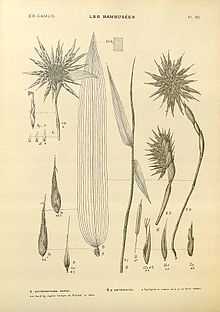Oxytenanthera
| savannah bamboo | |
|---|---|
 | |
| Oxytenanthera abyssinica[1] | |
| Scientific classification | |
| Kingdom: | Plantae |
| (unranked): | Angiosperms |
| (unranked): | Monocots |
| (unranked): | Commelinids |
| Order: | Poales |
| Family: | Poaceae |
| Subfamily: | Bambusoideae |
| Genus: | Oxytenanthera (A.Rich.) Munro |
| Binomial name | |
| Oxytenanthera abyssinica (A.Rich.) Munro | |
| Synonyms[2] | |
| |
Oxytenanthera is a genus of African bamboo in the grass family[3][4][5]
The only recognized species is Oxytenanthera abyssinica, widespread across much of sub-Saharan Africa from Senegal to Tanzania to Mpumalanga.[2] The genus formerly contained several Asiatic species, but these are now generally considered to be better suited to other genera (primarily Dendrocalamus or Gigantochloa but see also Bambusa Cephalostachyum Pseudoxytenanthera Schizostachyum Yushania);[6] However, molecular studies show species of Oxytenanthera quite distinct from Dendrocalamus spp.
Oxytenanthera is the most common lowland bamboo in eastern and central Africa, also called savannah bamboo.[7] It is common in the Southern Highlands of Tanzania in Iringa, Mbeya and Ruvuma Regions [8] where it is tapped for its juice, and fermented for the production of a local wine.
References
- ↑ 1913 illustration from English: Edmond Gustave Camus, Les bambusees, Atlas, vol. 2: plate 90 Source http://plantgenera.org/illustration.php?id_illustration=151808
- ↑ 2.0 2.1 Kew World Checklist of Selected Plant Families
- ↑ The Plant List search for Oxytenanthera
- ↑ Ohrnberger, D. (1999). The Bamboos of the World. Elsevier Science. p. 596. ISBN 978-0-444-50020-5.
- ↑ Munro, William 1868. Transactions of the Linnean Society of London 26(1): 126-130 descriptions in Latin, commentary in English
- ↑ Das, M., Bhattacharya, S., Singh, P., Filgueiras, T.S. and Pal, A. 2008. Bamboo taxonomy and diversity in the era of molecular markers. Advances in Botanical Research 47:225-268.
- ↑ Janzen, D.H. 1976. Why bamboos wait so long to flower. Annual Review of Ecology and Systematics 7:347-391.
- ↑ Mhando Leonardo (n.d.)
External links
- Oxytenanthera abyssinica in West African plants – A Photo Guide.
- Bamboos of India
- Common bamboo names
- Masman, W. 1995. Oxytenanthera. In: Bamboo names and synonyms.
- Mhando Leonardo (n.d.) The state of bamboo and rattan development in Tanzania. Tanzania Forest Research Institute-TAFORI.
- Pattanaik, S. and Hall, J.B. 2009. Species relationships in Dendrocalamus inferred from AFLP fingerprints. VIII World Bamboo Congress Proceedings, Vol. 5 Biology and Taxonomy; pp. 5-27 - 5-40.
- Ingram et al. 2010. The bamboo production to consumption system in Cameroon. INBAR and CIFOR.